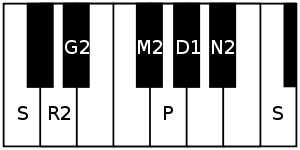Shanmukhapriya
Shanmukhapriya is a rāgam in Carnatic music (musical scale of South Indian classical music). It is the 56th melakarta rāgam (parent scale) in the 72 melakarta rāgam system of Carnatic music. It is called Chāmaram in Muthuswami Dikshitar school of Carnatic music.[1][2] It is said to be borrowed into Hindustani music from Carnatic music.[2] Many compositions on Lord Murugan and Lord Shiva are based on this raaga.
| Arohanam | S R₂ G₂ M₂ P D₁ N₂ Ṡ |
|---|---|
| Avarohanam | Ṡ N₂ D₁ P M₂ G₂ R₂ S |
| Carnatic music |
|---|
Tanjavur-style Tambura |
| Concepts |
| Compositions |
| Instruments |
|
Structure and Lakshana

It is the 2nd rāgam in the 10th chakra Disi. The mnemonic name is Disi-Sri. The mnemonic phrase is sa ri gi mi pa dha ni.[1] Its ārohaṇa-avarohaṇa structure (ascending and descending scale) is as follows (see swaras in Carnatic music for details on below notation and terms):
- ārohaṇa: S R₂ G₂ M₂ P D₁ N₂ Ṡ[lower-alpha 1]
- avarohaṇa: Ṡ N₂ D₁ P M₂ G₂ R₂ S[lower-alpha 2]
This scale uses the swaras chatushruti rishabham, sadharana gandharam, prati madhyamam, shuddha dhaivatam and kaisiki nishadam. As it is a melakarta rāgam, by definition it is a sampoorna rāgam (has all seven notes in ascending and descending scale). It is the prati madhyamam equivalent of Natabhairavi, which is the 20th melakarta scale.
Janya rāgams
Shanmukhapriya has a few minor janya rāgams (derived scales) associated with it. See List of janya rāgams for scales associated with Shanmukhapriya.
Compositions
A composition later set to Shanmukapriya
- Muthai tharu pathi by Arunagirinathar[3]
Here are a few common compositions sung in concerts, set to Shanmukhapriya.
- Vaddane vaaru by Tyagaraja
- Marivere Dikkevarayya by Patnam Subramania Iyer
- Parvati nayakane, Saravana bhava ennum, Andavane unnai by Papanasam Sivan
- Abhimaanamutho Nannubrovaradha by Mysore Vasudevachar
- Valli Nayakane by Muthiah Bhagavatar
- Vilayada idu nerama by T.N.Bala of USA
- Sada tava pAda sannidhim by M. Balamuralikrishna
- Omkara Pranava, a pada varnam in Shanmukhapriya by M. Balamuralikrishna
- Siddhi Vinayakam, by Muthuswami Dikshithar
- Stava Vârdita Vikramà by Kalyani Varadarajan
- Mamava Karunaya by Swathi Thirunal Rama Varma
The compositions of Muthuswami Dikshitar, namely, Siddhi Vinayakam, Mahasuram Ketumaham,sadashraye and Ekamreshanayakim have their school's rāgam name Chāmaram mudra in them.
Film Songs
Language:Tamil
| Song | Movie | Composer | Singer |
|---|---|---|---|
| Nenjil Kudiyirukkum | Irumbu Thirai | S. V. Venkatraman | T. M. Soundararajan, P. Leela |
| Arivukku Virunthaagum Thirukurale | Arivaali | T. M. Soundararajan | |
| Ninaindhu Ninaindhu Nenjam Urugudhe | Sadhaaram | G. Ramanathan | |
| Muthai Tharu | Arunagirinathar | T. R. Papa | |
| Adi Ennadi Rakkamma | Pattikada Pattanama | M. S. Viswanathan | |
| Maraindhirundhu | Thillana Mohanambal | K. V. Mahadevan | P. Susheela |
| Pazham Neeyappa | Thiruvilaiyadal | K. B. Sundarambal | |
| Thamthananam Thana | Puthiya Vaarpugal | Illayaraja | Jency Anthony,Sulochana |
| Thakita Thadimi | Salangai Oli | S. P. Balasubramanyam | |
| Kadhal Kasukuthaiya | Aan Paavam | Illayaraja | |
| Sollaayo Vaaithiranthu | Mogamul | M. G. Sreekumar, S. Janaki | |
| Ooruvittu Ooruvanthu | Karakattakkaran | Malaysia Vasudevan, Gangai Amaran | |
| Rajathi Raja | Mannan | S. P. Balasubramanyam, Swarnalatha | |
| Kannukkul Nooru | Vedham Pudhithu | Devendran | S. P. Balasubramanyam, K.S. Chitra |
| Saravanabava Ennum Thirumanthiram | Mettukudi | Sirpy | Mano |
| Mudhal Kanave | Majunu | Harris Jayaraj | Harish Raghavendra, Bombay Jayashree,O.S.Arun |
| Athini Chitthini(Raga Panthuvarali traces too) | Thenali | A. R. Rahman | Hariharan, Chitra Sivaraman |
Related rāgams
This section covers the theoretical and scientific aspect of this rāgam.
Shanmukhapriya's notes when shifted using Graha bhedam, yields 3 other major melakarta rāgams, namely, Shoolini, Dhenuka and Chitrambari. Graha bhedam is the step taken in keeping the relative note frequencies same, while shifting the shadjam to the next note in the rāgam. For further details and an illustration refer Graha bhedam on Shanmukhapriya.
Shanmukhapriya corresponds to Hungarian Gypsy scale in Western music.
Notes
- Alternate notations:
- Hindustani: S R G̱ M̄ P Ḏ Ṉ Ṡ
- Western: C D E♭ F♯ G A♭ B♭ C
- Alternate notations:
- Hindustani: Ṡ Ṉ Ḏ P M̄ G̱ R S
- Western: C B♭ A♭ G F♯ E♭ D C
References
- Ragas in Carnatic music by Dr. S. Bhagyalekshmy, Pub. 1990, CBH Publications
- Raganidhi by P. Subba Rao, Pub. 1964, The Music Academy of Madras
- "A Raga's Journey – Sacred Shanmukhapriya". The Hindu. 2 September 2011.